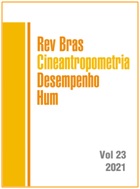Variations of workload and well-being measures across a professional basketball season
DOI:
https://doi.org/10.1590/1980-0037.2021v23e75863Abstract
The aims of this study were: (i) to describe weekly variations of acute load (AL), acute:chronic workload ratio, delayed onset muscle soreness (DOMS), and fatigue; (ii) to analyze variations of weekly workload and well-being in three periods of the season (P1, P2, and P3); and (iii) to analyze the relationships between workload and well-being measures. Fifteen professional basketball players from a first-league European club were monitored throughout the season using the CR-10 Borg scale and the Hooper questionnaire. Weekly AL and acute:chronic workload ratio (ACWR) were weekly calculated for monitoring of the internal load. In addition, DOMS and fatigue values were weekly calculated. Greater AL, DOMS, and fatigue values were found during the early season, and the highest ACWR value was found during the second period. Overall, AL presented large correlations with DOMS (r=0.60) and fatigue (r=0.62). The results of this study indicate that load is higher in the first period and then decreases throughout the season. The results also showed that AL is more closely related to well-being parameters than ACWR.
References
Nunes JA, Costa EC, Viveiros L, Moreira A, Aoki MS. Monitoramento da carga interna no basquetebol. Rev Bras Cineantropom Desempenho Hum. 2011;13(1):67–72. DOI: 10.5007/1980-0037.2011v13n1p67
Klusemann MJ, Pyne DB, Hopkins WG, Drinkwater EJ. Activity profiles and demands of seasonal and tournament basketball competition. Int J Sports Physiol Perform. 2013;8(6):623–629. DOI: 10.1123/ijspp.8.6.623
Borresen J, Lambert MI. The Quantification of Training Load , Effect on Performance. Sport Med. 2009;39(9):779–795. DOI: 10.2165/11317780-000000000-00000
Taylor JB, Wright AA, Dischiavi SL, Townsend MA, Marmon AR. Activity Demands During Multi-Directional Team Sports: A Systematic Review. Sport Med [Internet]. 2017;12;47(12):2533–2551. Available from: http://link.springer.com/10.1007/s40279-017-0772-5
Clemente FM, Silva AF, Clark CCT, Conte D, Ribeiro J, Mendes B, et al. Analyzing the Seasonal Changes and Relationships in Training Load and Wellness in Elite Volleyball Players. Int J Sports Physiol Perform. 2020;15(5):731–740. DOI: 10.1123/ijspp.2019-0251
Rabelo FN, Pasquarelli BN, Gonçalves B, Matzenbacher F, Campo F, Sampaio J, et al. Monitoring the intended and perceived training load of a professional futsal team over 45 weels: a case study. J Strength Cond Res. 2016;30(1):134-140. DOI: 10.1519/JSC.0000000000001090
Foster C. Monitoring training in athletes with reference to overtraining syndrome. Med Sci Sports Exerc. 1998;30(7):1164–1168. DOI: 10.1097/00005768-199807000-00023
Halson SL. Monitoring Training Load to Understand Fatigue in Athletes. Sport Med [Internet]. 2014;44(Suppl 2):139–147. DOI: 10.1007/s40279-014-0253-z
Malone JJ, Lovell R, Varley MC, Coutts AJ. Unpacking the Black Box : Applications and Considerations for Using GPS Devices in Sport. Int J Sports Physiol Perform. 2017;12(Suppl 2):S218-S226. DOI: 10.1123/ijspp.2016-0236
Oliveira e Silva PMM, Mendes R, Santos P, Rocha JM. Fatores de carga externa e interna associados com a percepção subjetiva de esforço no futebol de elite. Centro de Pesquisa e Desenvolvimento Desportivo. 2016;1–14. Avaliable from: http://formacao.comiteolimpicoportugal.pt/PremiosCOP/COP_PFO_MH/file009.pdf
Haddad M, Chaouachi A, Wong DP, Castagna C, Hambli M, Hue O, et al. Influence of fatigue, stress, muscle soreness and sleep on perceived exertion during submaximal effort. Physiol Behav. 2013;119:185–189. DOI: 10.1016/j.physbeh.2013.06.016
Foster C, Florhaug JA, Franklin J, Gottschall L, Hrovatin LA, Parker S, et al. A New Approach to Monitoring Exercise Training. J Strength Cond Res. 2001;15(1):109–115. Avaliable from: https://pubmed.ncbi.nlm.nih.gov/11708692/
Bowen L, Gross AS, Gimpel M, Li F-X, Malone JJ, Lovell R, et al. Accumulated workloads and the acute:chronic workload ratio relate to injury risk in elite youth football players. Br J Sports Med. 2017;51(5):452–459. DOI: 10.1136/bjsports-2015-095820
Maupin D, Schram B, Canetti E, Orr R. The Relationship Between Acute: Chronic Workload Ratios and Injury Risk in Sports: A Systematic Review. Open Access J Sport Med. 2020;11:51–75. DOI: 10.2147/OAJSM.S231405
Conte D, Kolb N, Scanlan AT, Santolamazza F. Monitoring Training Load and Well-Being During the In-Season Phase in National Collegiate Athletic Association Division I Men ’ s Basketball. Int J Sport Physiol Perform. 2018;13(8):1067–1074. DOI: 10.1123/ijspp.2017-0689
Hooper SL, Mackinnon LT. Monitoring Overtraining in Athletes. Recommendations. Sports Med. 1995;20(5):321–327. DOI: 10.2165/00007256-199520050-00003
Chang C, Putukian M, Aerni G, Diamond A, Hong G, Ingram Y, et al. Mental health issues and psychological factors in athletes: Detection, management, effect on performance and prevention: American Medical Society for Sports Medicine Position Statement-Executive Summary. Br J Sports Med. 2020;54(4):216–220. DOI: 10.1136/bjsports-2019-101583
Moreira A, Arsati F, Cury PR, Franciscon C, Simões AC, de Oliveira PR, et al. The impact of a 17-day training period for an international championship on mucosal immune parameters in top-level basketball players and staff members. Eur J Oral Sci. 2008;116(5):431–437. DOI: 10.1111/j.1600-0722.2008.00558.x
Borg G. Perceived exertion and pain scales. Champaign IL, USA: Human Kinetics; 1998.
Hulin BT, Gabbett TJ, Lawson DW, Caputi P, Sampson JA. The acute:chronic workload ratio predicts injury: high chronic workload may decrease injury risk in elite rugby league players. Br J Sports Med. 2016;50(4):231–236. DOI: 10.1136/bjsports-2015-094817



